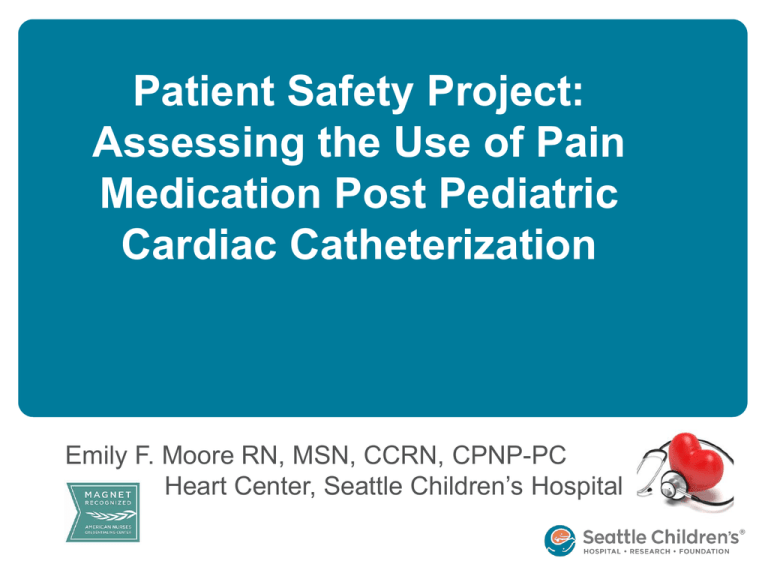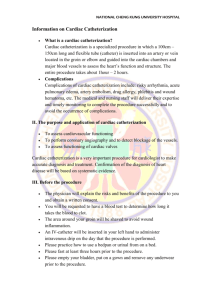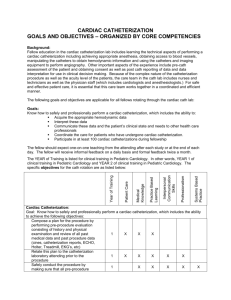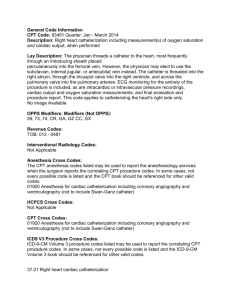Patient Safety Project: Assessing the Use of Pain Medication Post
advertisement

Patient Safety Project: Assessing the Use of Pain Medication Post Pediatric Cardiac Catheterization Emily F. Moore RN, MSN, CCRN, CPNP-PC Heart Center, Seattle Children’s Hospital Disclosure statement I do not have any relevant financial relationships with any commercial interests to disclose Problem Identification • Cardiac catheterizations cause stress to patients and families Picture •Here Little data exists regarding immediate post cardiac (rounded catheterization pain corners optional) • Data is scarce related to pain post discharge Significance • Congenital heart disease effects 8 per 1000 live births Picture • Approximately 2 to 4 of these infants require cardiac Here catheterization and/or cardiac surgery (rounded corners optional) • The complication rate is low • Adverse events are defined as any anticipated or unanticipated event caused by a cardiac catheterization Purpose • The purpose of our study was to determine if pain after an outpatient invasive catheter based procedure was clinically important. Specific Aims • Describe pain reported post cardiac catheterization • Describe medication usage post cardiac catheterization • Describe the adequacy of analgesics used • Examine factors associated with inadequate analgesics Quality Improvement Study • Expedited as a result of a sentinel event • Prompted a thorough evaluation of policy and procedure regarding treatment of acute post procedural pain • Directly effected pain management in the cardiac catheterization labs What we know about pain • A subjective experience described as an unpleasant sensory and emotional experience associated with tissue damage. In conjunction with any medical intervention that may be potentially painful or cause anxiety can be referred to as procedural pain • Psychological effects of poor pain management in children may have significant life long damage Methods • Design: • Prospective cohort study using a phone survey • IRB exemption was obtained • Subjects: • All cardiac catheterization patients ranging from day 1 of life to 23 years old (excluded ICD and pacemakers) Methods • Setting: • Tertiary care center serving the WWAMI region Methods • Instruments: • Questionnaire designed to asses post cardiac catheterization pain • Wong Baker FACES scale Procedures • Nurses attended a training specific to pain assessment • Standard procedure was implemented regarding follow up phone calls • Patients and families were assessed pre-operatively regarding ability to rate pain • Patients and families were informed they would receive a phone call at 1-2 days post procedure to follow up and assess pain Data Analysis • Patients were broken into two groups • Those who experienced pain • Those who did not • SPSS statistical software was used to evaluate data • Fisher’s exact test Results Demographics and case detail n (%) Total number of procedures 1045 Total number contacted 745 (72) Gender Male 409 (55) Ethnicity Caucasian 581 (78) African American 60 (8) Asian American 60 (8) Native American 30 (4) Other 15 (2) Diagnostic 231 (31) Interventional 395 (53) Electrophysiology 120 (16) Arterial 417 (56) Venous 731 (98) Type of procedure Access Results • 72% responded by phone 48 hours after procedure • 98% (731) experienced no pain or pain relieved by acetaminophen Results • 14 patients had pain unrelieved by acetaminophen • Seven (7) complained of generalized discomfort related to procedural positioning (lying flat) for several hours • Nearly half had important complications at the site of vascular access • Six (6) with hematomas at the access site • One (1) with pseudoaneurysm Results • Based on a Fisher’s exact test, post procedural pain unrelieved by acetaminophen had a statistically significant association with complications at 0.02% (p <0.01) Discussion • Pain was typically mild • Pain unrelieved with acetaminophen could be an indicator for complications • The importance of pain may have been missed had opioids been prescribed without evidence of need • A large number of patients avoided unnecessary exposure to opioids Conclusion • Opioid use following a pediatric cardiovascular invasive procedure is not required and if utilized may mask clinically important pain • A pseudoaneurysm may had been missed had this project not been initiated and the patient been sent home with an opioid prescription Practice Change • Families were provided with detailed instructions regarding new process • A phone survey was designed and implemented • Efforts were focused on actual patient need versus varied opinions regarding perceived pain • Through CPI we knew, any patient identified to have pain unrelieved by acetaminophen needed to be immediately discussed with the team Recommendations moving forward • All patients should receive close follow up • Importance should be placed on same day procedures • Acetaminophen should be sufficient to treat pain • Any patient who reports pain unrelieved by acetaminophen should be assessed by the healthcare team Acknowledgements • • • • Jack Salerno MD Arlene Armatage RN Jenny Keylon RN Karen Thomas References • • • • • • • • American Academy of Pediatrics. Committee on Psychosocial Aspects of Child and Family Health. Task Force on Pain in Infants, Children,and Adolescents. (2001). The assessment and management of acute pain in infants, children, and adolescents. Pediatrics, 108(3), 793-797. Bergersen, L., Gauvreau, K., Marshall, A., Kreutzer, J., Beekman, R., Hirsch, R., . . . Jenkins, K. (2011). Proceduretype risk categories for pediatric and congenital cardiac catheterization. Circulation.Cardiovascular Interventions, 4(2), 188-194. doi:10.1161/CIRCINTERVENTIONS.110.959262 [doi] Brasher, C., Gafsous, B., Dugue, S., Thiollier, A., Kinderf, J., Nivoche, Y., . . . Dahmani, S. (2014). Postoperative pain management in children and infants: An update. Paediatric Drugs, 16(2), 129-140. doi:http://dx.doi.org/10.1007/s40272-013-0062-0 Jacob, E. (2007). Pain assement and management in children. In C. Jackson, & M. Hayden (Eds.), Wong's nursing care of infants and children (Eighth ed., pp. 205-210) Elsevier. LeRoy, S., Elixson, E. M., O'Brien, P., Tong, E., Turpin, S., Uzark, K., . . . Council on Cardiovascular Diseases of the,Young. (2003). Recommendations for preparing children and adolescents for invasive cardiac procedures: A statement from the american heart association pediatric nursing subcommittee of the council on cardiovascular nursing in collaboration with the council on cardiovascular diseases of the young. Circulation, 108(20), 2550-2564. Russell, P., von Ungern-Sternberg, B. S., & Schug, S. A. (2013). Perioperative analgesia in pediatric surgery. Current Opinion in Anaesthesiology, 26(4), 420-427. doi:http://dx.doi.org/10.1097/ACO.0b013e3283625cc8 Wells, N., Pasero, C., & McCaffery, M. (2008). Improving the quality of care through pain assessment and management. In R. G. Hughes (Ed.), Patient safety and quality: An evidence-based handbook for nurses (). Rockville (MD): doi:NBK2658 [bookaccession] Wensley, C. J., Kent, B., McAleer, M. B., Price, S. M., & Stewart, J. T. (2008). Pain relief for the removal of femoral sheath in interventional cardiology adult patients. The Cochrane Database of Systematic Reviews, (4):CD006043. doi(4), CD006043. doi:10.1002/14651858.CD006043.pub2 [doi] Thanks!







